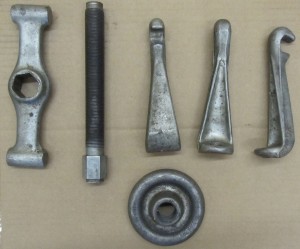The Saywards documented a 36 P2 Plymouth Rear Brake Replacement in this account of some of the “Gritty” details of the task that could apply to most Chrysler products up to the 60’s:
36 P2 Plymouth Rear Brake Replacement
Roland hit on some of what most must be prepared to do in terms of finding parts, somewhat tasking dis-assembly, fit up issues, and finally the inevitable “What to do” about remaining issues…….. In this case the drum diameter and brake lining arc matching.
Twenty years ago machine shops were plentiful that had the capability to turn the drums and arc the lining to match. Today it takes a search to find that shop in your area with the equipment to arc the lining to match the drum diameter.
When it comes to fit up the inevitable thread mismatch measured in thousands of an inch may need some nudging with a die or tap of the correct size.
Rear brakes due to their location take a corrosion beating especially when they are used infrequently and/or sit idle for a period of time. So a rugged puller capable of sledge hammer blows is needed to pull the drum. Brake cylinders frequently need machining to clean out the bores after stuck pistons are removed. And finally the brake line fittings can be frozen in place and frequently snap off.
Finally (in terms of the last step in the job) is the brake adjustment of the linings relative to the drum. Chrysler provided an almost unlimited variable adjustment capability of anchor pivot and lining clearance to the drum but it takes multiple adjusting steps to get it to line up without use of the special tool that Chrysler Assembly plants had at their fingertips. It can be done with patience to give correct clearances when brakes are not applied and uniform lining to drum pressure…..but be prepared to spend some time to get it right since you are using the brake drum as your measuring gauge. Some cut out an old brake drum with peep holes so they can measure the clearances with a feeler gauge…..a nifty trick.
Be prepared for the above and your brake job will come out fantastic. Of course the Region has a brake drum puller for such a job on Chrysler Products up and into the 60s:
Just send us a comment so we can get you hooked up at one of our upcoming Region Events and you can “Break Out Of” your motionless Plymouth syndromes!


Hello. I have a 1936 NZ new Plymouth P2 Continental coupe that has ripped the rear brake drum away from the stub. It appears that the drum has been replaced and was machined and tagged the two componants together, which probably is not good practise.
Do you know were i could find/purchase 2 x rear brake drums for this model. Any info would be very much appreciated
I can run an ad in the website “Wanted” section. It would be helpful (and increase your odds at finding one) if you provide the range of rear brake applications that are identical. (Maybe one of our 36 Ply knowledgeable members can help on that task) You might find that 34 up to 36 might fit with the same drum diameter & rear wheel hub for instance.
My Plymouth Master Maintenance Manual covers 34 to 36 and has the same rear brake illustration and instructions for each year. It also shows the rear brake drum RIVETED to the rear wheel hub. My 35 Dodge Master Maintenance Manual also shows the rear brake drum RIVETED to the rear wheel hub. Consequently I’m confused why your drum is tack welded to the hub (if that’s your meaning of “stub”).
If your brake drum outer rim is separating from the balance of the brake drum at the factory stitch or tack welds then those welds can be improved. There are several website articles on the procedure which consists essentially of lining up the original stitch welds and welding again just as the factory did with a competent welder.
Based on the above I think you may find the rear wheel hub is sold separately from the rear wheel brake drum and the purchaser must rivet the two together in order to have the assembly you might be looking to purchase. I would also expect that after riveting the two pieces together the purchaser must machine the assembly to insure the brake surface and hub are centered concentric.
Do you have a service manual for your particular 36? Does it cover multiple years? That knowledge may be helpful in solving your needs. I can post a copy of my 34 to 36 Ply Master Maintenance rear brake illustration showing the riveted brake drum to the hub on this website if that would help. I can add the illustration to this post.
Meanwhile send a picture, a description, and contact info so I can put it in your “Wanted” ad.
Also recommend you contact the following vendor after you check out their website for the following 36 to 38 Plymouth Rear Brake Drum 862-356:
http://www.atlaschrys.com/Early/Brakes/EarlyRearBrakeDrums.html
Don